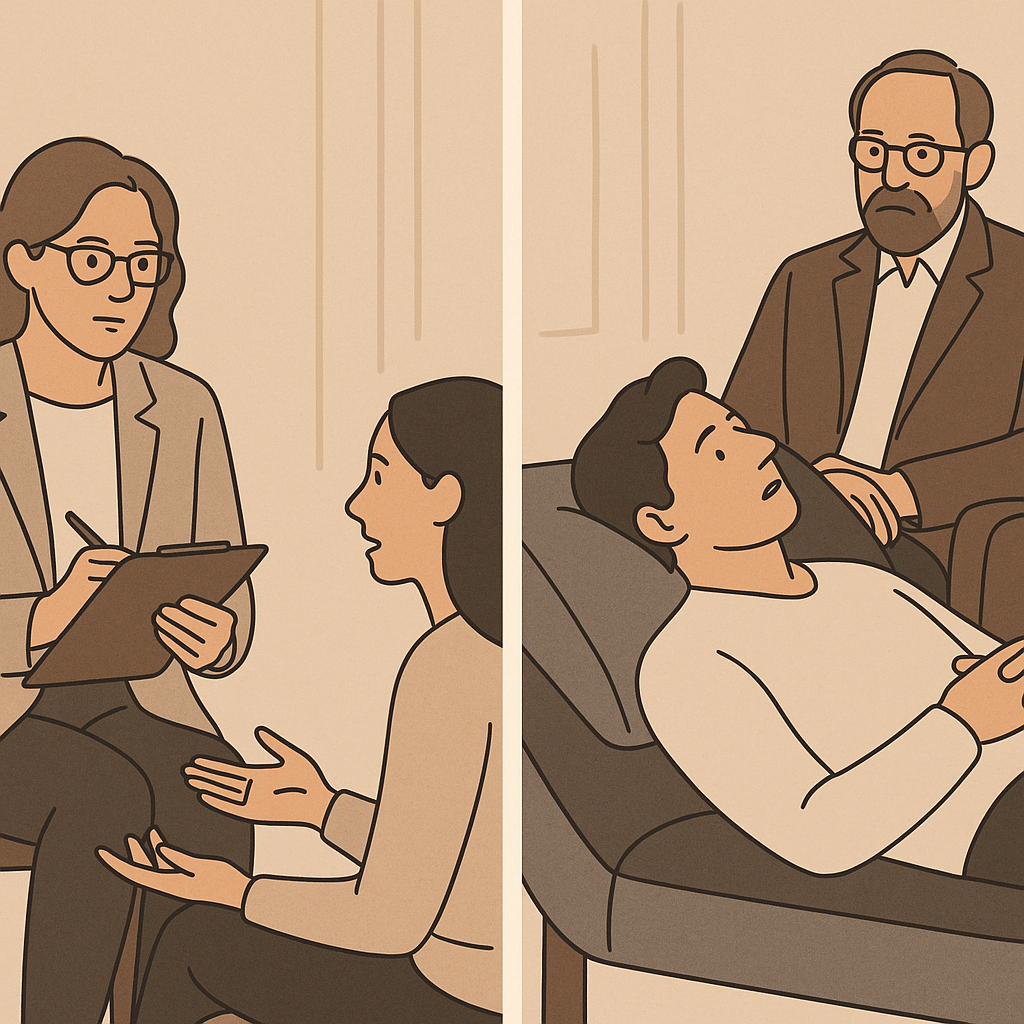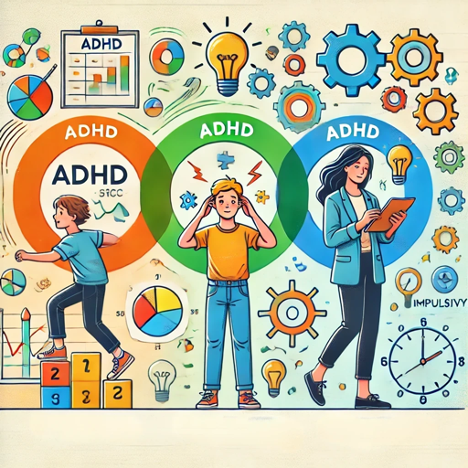
Mental health treatment has evolved tremendously over the decades, offering individuals various pathways to healing and personal growth. Among the most established and researched therapeutic approaches are Cognitive Behavioral Therapy (CBT) and Psychodynamic Therapy. While both aim to improve mental well-being, they differ significantly in their methods, focus, and applications. Understanding these differences can help you make an informed decision about which approach might be most beneficial for your unique needs.
Understanding CBT: The Problem-Solving Approach
What is CBT?
Cognitive Behavioral Therapy is a structured, goal-oriented approach that focuses on identifying and changing negative thought patterns to improve emotional and behavioral outcomes. Developed from the work of pioneers like Aaron Beck and Albert Ellis, CBT operates on the fundamental principle that our thoughts, feelings, and behaviors are interconnected and influence each other.
Core Principles of CBT
1. The Cognitive Triangle CBT recognizes that thoughts, feelings, and behaviors are interconnected. When you change one element, it affects the others. For example, changing negative thought patterns can lead to improved mood and more adaptive behaviors.
2. Present-Focused Solutions Rather than delving extensively into past experiences, CBT emphasizes addressing current challenges and developing practical strategies for managing present-day symptoms.
3. Skill-Building Orientation CBT provides clients with concrete tools and techniques they can use independently to manage their mental health concerns.
Key CBT Techniques
- Cognitive Restructuring: Identifying and challenging distorted thinking patterns
- Behavioral Activation: Increasing engagement in meaningful activities
- Exposure Therapy: Gradual confrontation of feared situations or objects
- Mindfulness Techniques: Developing present-moment awareness
- Problem-Solving Skills: Learning systematic approaches to addressing challenges
CBT Effectiveness: What the Research Shows
The evidence base for CBT is extensive and impressive. According to research from the Beck Institute, more than 2,000 studies have demonstrated CBT’s efficacy for psychiatric disorders, psychological problems, and medical conditions with psychiatric components.
Key Research Findings:
- CBT has been shown to be effective for anxiety disorders, depression, PTSD, eating disorders, and substance abuse
- Studies consistently show that CBT leads to significant improvement in functioning and quality of life
- Research indicates that 43% of people who received CBT showed at least a 50% reduction in depression symptoms over 46 months
- CBT is considered the “gold standard” treatment for anxiety and stress-related disorders
Understanding Psychodynamic Therapy: The Insight-Oriented Approach
What is Psychodynamic Therapy?
Psychodynamic therapy is rooted in psychoanalytic principles, focusing on uncovering unconscious processes and their influence on thoughts, emotions, and behaviors. This approach emphasizes the therapeutic relationship and explores how past experiences, particularly from childhood, shape current patterns of thinking and relating.
Core Principles of Psychodynamic Therapy
1. The Unconscious Mind Psychodynamic therapy operates on the belief that unconscious thoughts, desires, and memories significantly impact behavior and emotional experiences.
2. Early Life Experiences The approach emphasizes how childhood relationships and experiences create templates for adult relationships and emotional patterns.
3. Therapeutic Relationship The client-therapist relationship serves as a crucial vehicle for healing, with phenomena like transference and countertransference providing important therapeutic material.
4. Defense Mechanisms Understanding how individuals protect themselves from psychological pain through various defense mechanisms is central to this approach.
Key Psychodynamic Techniques
- Free Association: Encouraging spontaneous expression of thoughts and feelings
- Dream Analysis: Exploring unconscious material through dream content
- Interpretation: Helping clients understand unconscious patterns and conflicts
- Exploration of Transference: Examining how past relationships influence the therapeutic relationship
- Working Through: Repeatedly exploring and understanding patterns until lasting change occurs
Psychodynamic Therapy Effectiveness: The Evidence
While psychodynamic therapy has been critiqued for lacking empirical support, recent comprehensive reviews show substantial evidence for its effectiveness. A major review published in PMC found:
Key Research Findings:
- Psychodynamic therapy shows significant effectiveness for depression, anxiety disorders, eating disorders, and somatic problems
- Particularly strong evidence exists for treating personality disorders, especially borderline personality disorder
- Long-term psychodynamic therapy shows continued improvement even after treatment ends
- Studies demonstrate large pre-post treatment effects that are maintained at one-year follow-up
Head-to-Head Comparison: CBT vs. Psychodynamic Therapy
1. Focus and Approach
CBT:
- Present-focused: Concentrates on current thoughts, feelings, and behaviors
- Problem-solving oriented: Emphasizes practical solutions to immediate concerns
- Symptom-targeted: Directly addresses specific symptoms and disorders
Psychodynamic Therapy:
- Past-informed: Explores how early experiences influence current patterns
- Insight-oriented: Focuses on understanding underlying psychological processes
- Relationship-focused: Emphasizes the therapeutic relationship as a vehicle for change
2. Treatment Structure and Duration
CBT:
- Highly structured: Sessions follow a clear agenda with specific goals
- Short-term: Typically 12-20 sessions for many conditions
- Homework assignments: Clients practice skills between sessions
- Measurable outcomes: Progress is tracked through specific metrics
Psychodynamic Therapy:
- Open-ended structure: Sessions unfold more organically based on client material
- Variable duration: Can be short-term (20-25 sessions) or long-term (1+ years)
- Process-oriented: Focuses on exploring patterns and gaining insight
- Relationship-based progress: Change occurs through the therapeutic relationship
3. Therapeutic Goals
CBT Goals:
- Develop practical coping strategies
- Change maladaptive thought patterns
- Increase behavioral activation
- Achieve symptom reduction
- Prevent relapse through skill maintenance
Psychodynamic Goals:
- Increase self-awareness and insight
- Understand unconscious patterns
- Resolve internal conflicts
- Improve relationship patterns
- Develop emotional resilience
4. Role of the Therapist
CBT Therapist:
- Active and directive: Guides sessions with structure and specific interventions
- Teacher/coach role: Educates clients about techniques and skills
- Collaborative problem-solver: Works with clients to identify solutions
- Homework assigner: Provides between-session assignments
Psychodynamic Therapist:
- Less directive: Allows sessions to unfold based on client material
- Facilitator of insight: Helps clients discover patterns and meanings
- Container for emotions: Provides a safe space for emotional exploration
- Interpreter: Offers understanding of unconscious processes
5. Conditions Best Treated
CBT is particularly effective for:
- Anxiety disorders (generalized anxiety, social anxiety, panic disorder)
- Depression (especially with clear cognitive distortions)
- PTSD and trauma-related disorders
- Obsessive-compulsive disorder
- Eating disorders (especially bulimia nervosa)
- Substance abuse disorders
- Specific phobias
Psychodynamic Therapy is particularly effective for:
- Personality disorders (especially borderline personality disorder)
- Complex trauma and attachment issues
- Chronic depression with interpersonal themes
- Relationship difficulties
- Identity and self-esteem issues
- Somatic disorders and chronic pain
- Eating disorders (especially anorexia nervosa)
Recent Research Comparisons
Depression Treatment
Recent studies comparing CBT and psychodynamic therapy for depression show interesting patterns:
- Short-term outcomes: CBT often shows more rapid symptom reduction
- Long-term outcomes: Both approaches show similar effectiveness at follow-up
- Patient preference: Many patients express preference for psychodynamic therapy when given a choice
- Combination approaches: Adding psychodynamic therapy to medication shows higher recovery rates (59% vs. 41%) compared to medication alone
Anxiety Disorders
For anxiety disorders, research indicates:
- CBT: Shows clear superiority for specific phobias and OCD
- Psychodynamic Therapy: Shows promise for social anxiety and generalized anxiety disorder
- Long-term follow-up: Differences between approaches often disappear at 2-year follow-up
- Cost-effectiveness: CBT proved cost-effective at lower willingness-to-pay thresholds
Personality Disorders
For complex personality disorders:
- Psychodynamic approaches: Show stronger evidence, particularly for borderline personality disorder
- Specialized treatments: Mentalization-based treatment and transference-focused psychotherapy have strong research support
- Long-term benefits: Psychodynamic approaches show sustained improvement over time
Choosing the Right Approach for You
Consider CBT if you:
- Prefer a structured, goal-oriented approach
- Want to focus on specific symptoms or problems
- Are looking for practical tools and strategies
- Prefer shorter-term treatment
- Have anxiety disorders, depression, or PTSD
- Like homework assignments and skill practice
- Want measurable progress tracking
Consider Psychodynamic Therapy if you:
- Are interested in understanding deeper patterns
- Want to explore how your past influences your present
- Are dealing with relationship difficulties
- Have complex or chronic mental health issues
- Prefer a more exploratory, open-ended approach
- Are willing to commit to longer-term treatment
- Want to focus on personal growth and self-awareness
Consider Combined or Integrative Approaches if you:
- Want both practical skills and deeper understanding
- Have complex presentations that might benefit from multiple approaches
- Are open to different phases of treatment with different focuses
- Want the benefits of both symptom relief and insight
Making Your Decision: Practical Considerations
Therapist Training and Competence
Both approaches require specialized training. Look for therapists who:
- Have specific training in the approach you’re considering
- Are licensed mental health professionals
- Have experience treating your specific concerns
- Demonstrate competence in their chosen modality
Cost and Insurance Coverage
- CBT: Often preferred by insurance companies due to shorter duration
- Psychodynamic Therapy: May require longer treatment, affecting cost considerations
- Check your insurance coverage and out-of-pocket expenses for both approaches
Personal Fit
The therapeutic relationship is crucial for both approaches. Consider:
- Your comfort level with the therapist’s style
- Whether you feel heard and understood
- Your willingness to engage in the type of work required
- Your motivation for the specific approach
The Future of Therapeutic Integration
Modern mental health treatment increasingly recognizes that different approaches may be beneficial at different times or for different aspects of a person’s concerns. Many therapists now integrate elements from both CBT and psychodynamic approaches, creating personalized treatment plans that draw from the strengths of each modality.
Emerging Trends:
- Process-based therapy: Focusing on specific psychological processes rather than diagnostic categories
- Modular approaches: Combining specific techniques from different therapies based on individual needs
- Technology integration: Online delivery of both CBT and psychodynamic interventions
- Precision medicine: Using individual characteristics to predict which approach will be most effective
Conclusion: Both Paths Lead to Healing
The choice between CBT and psychodynamic therapy isn’t necessarily about finding the “best” approach – it’s about finding the right fit for your unique needs, preferences, and circumstances. Both therapies have strong research support and can lead to significant improvement in mental health and quality of life.
Key Takeaways:
- CBT offers practical, skill-based solutions with typically faster symptom relief
- Psychodynamic therapy provides deeper insight and understanding of patterns
- Both approaches are effective for many conditions, with some specific advantages for different disorders
- The therapeutic relationship is crucial regardless of the approach chosen
- Many people benefit from integrative approaches that combine elements of both
Remember that seeking therapy is a courageous step toward better mental health. Whether you choose CBT, psychodynamic therapy, or an integrative approach, the most important factor is finding a qualified therapist with whom you feel comfortable and can build a strong therapeutic alliance.
If you’re considering therapy, consult with mental health professionals who can help assess your specific needs and recommend the most appropriate approach for your situation. Your journey toward better mental health is unique, and the right therapeutic approach can provide the support and tools you need to thrive.


